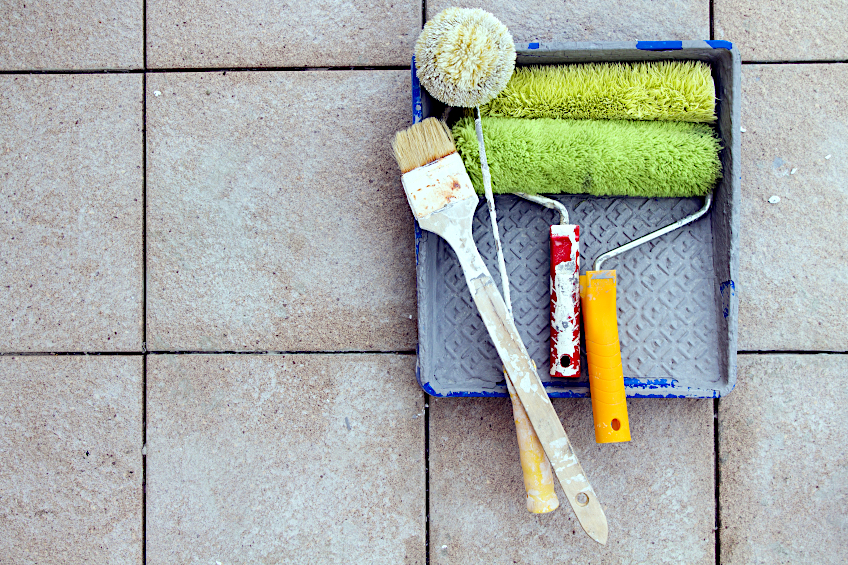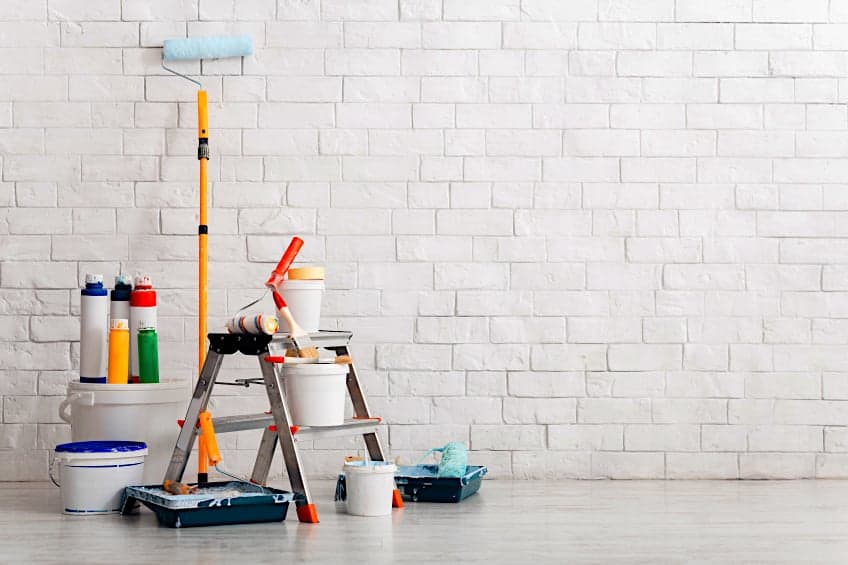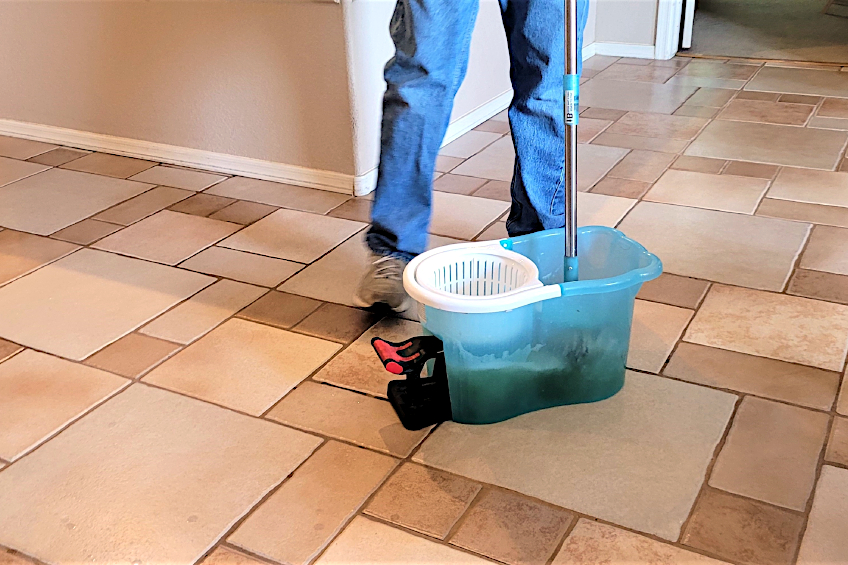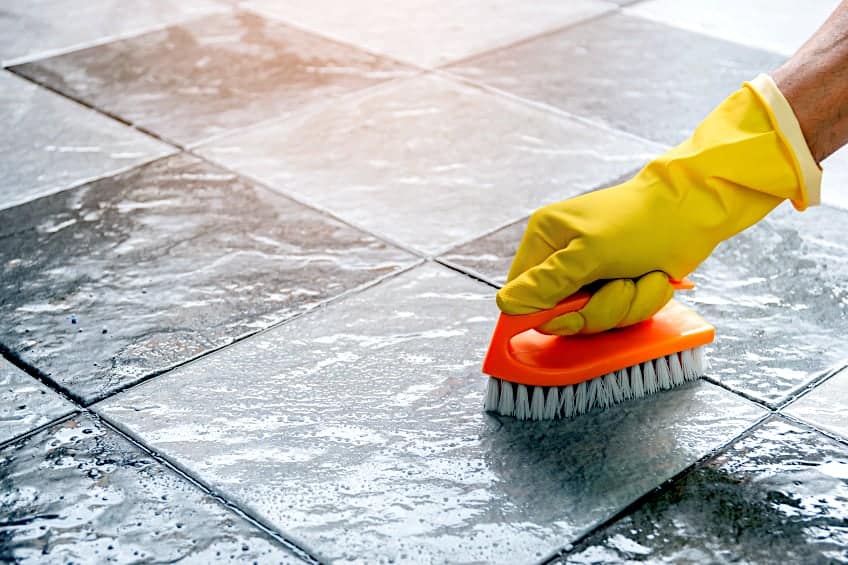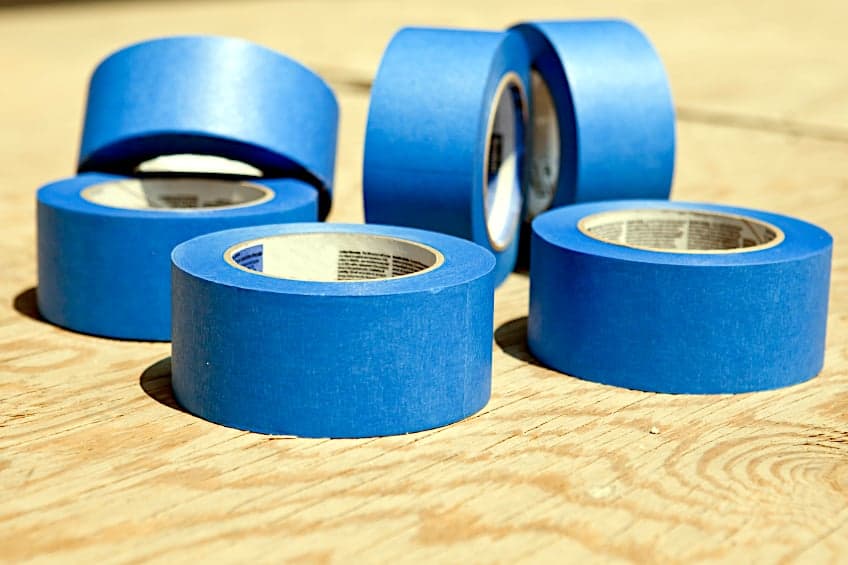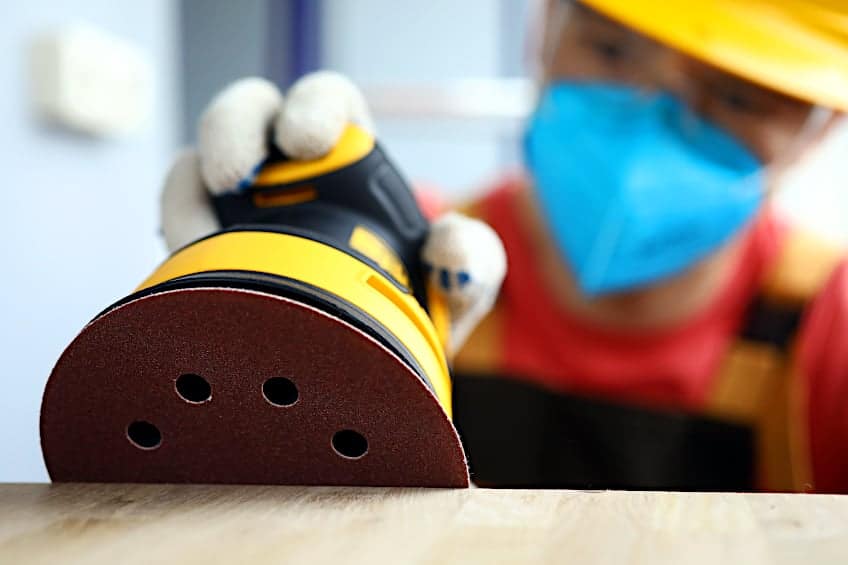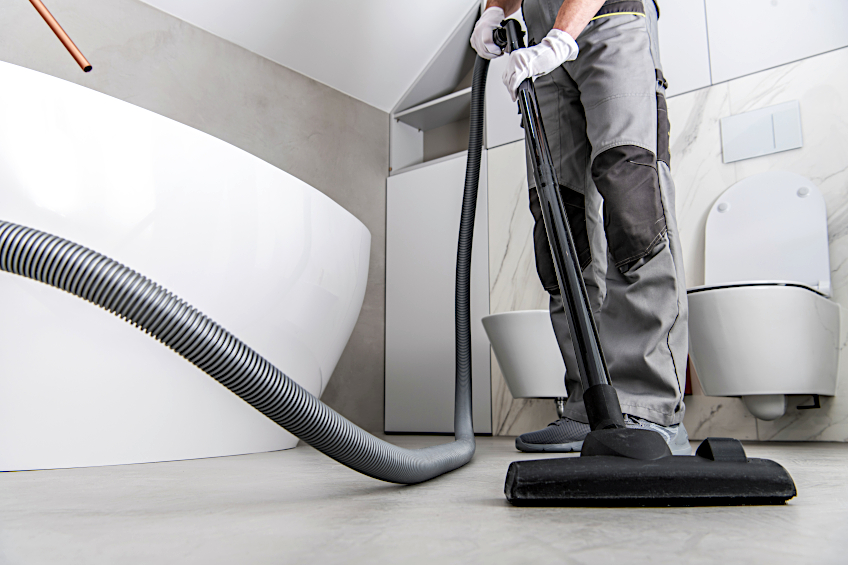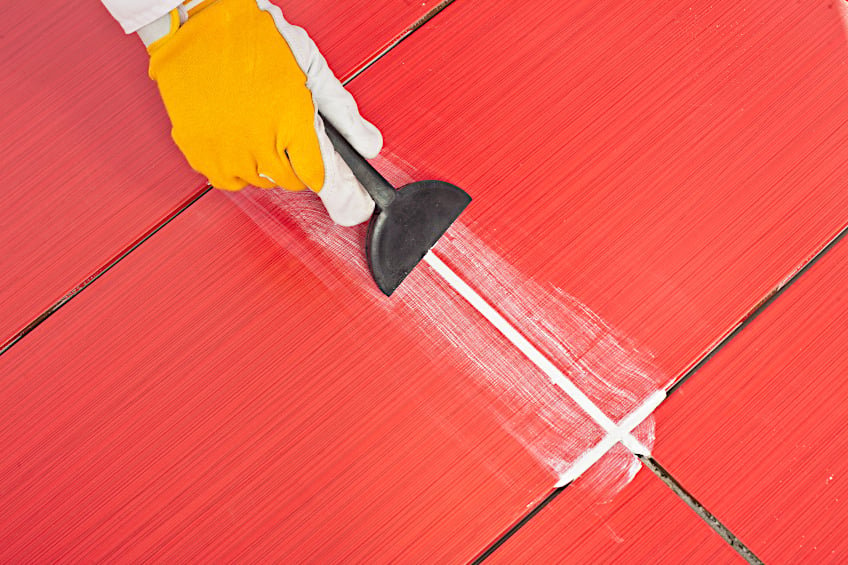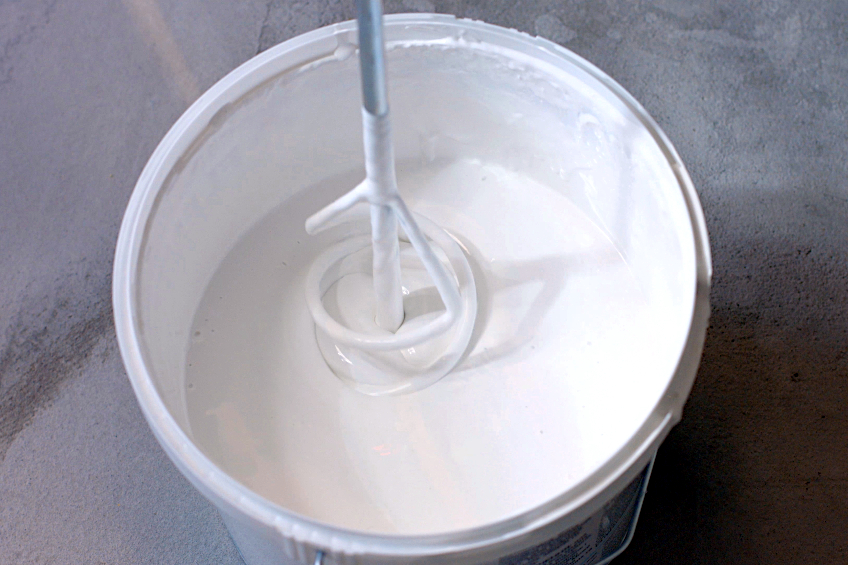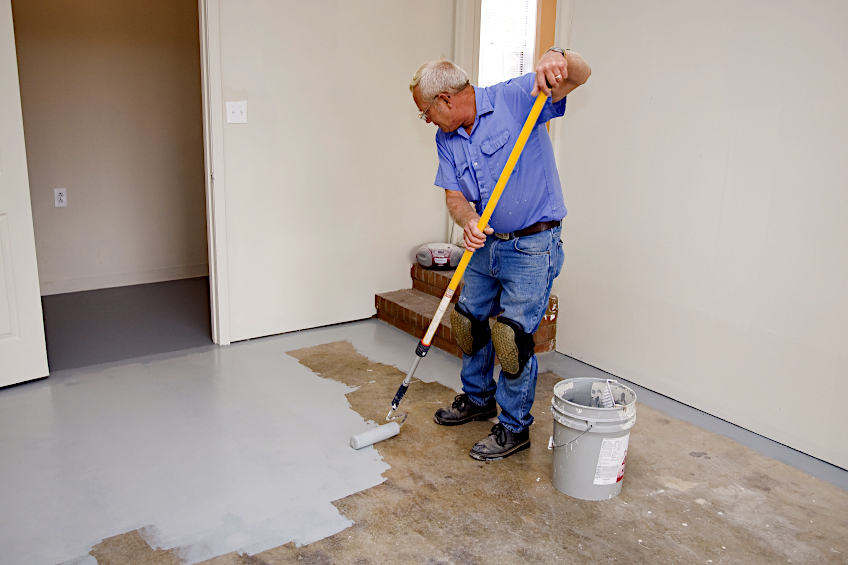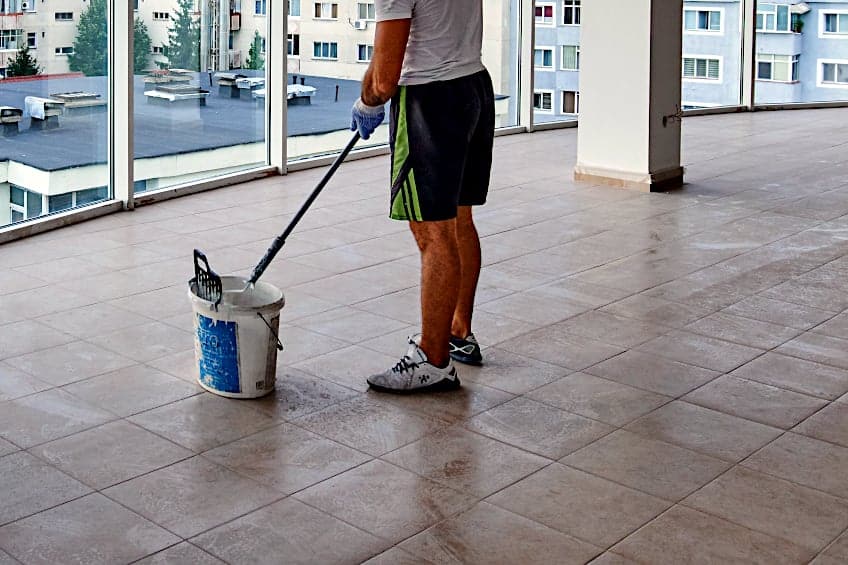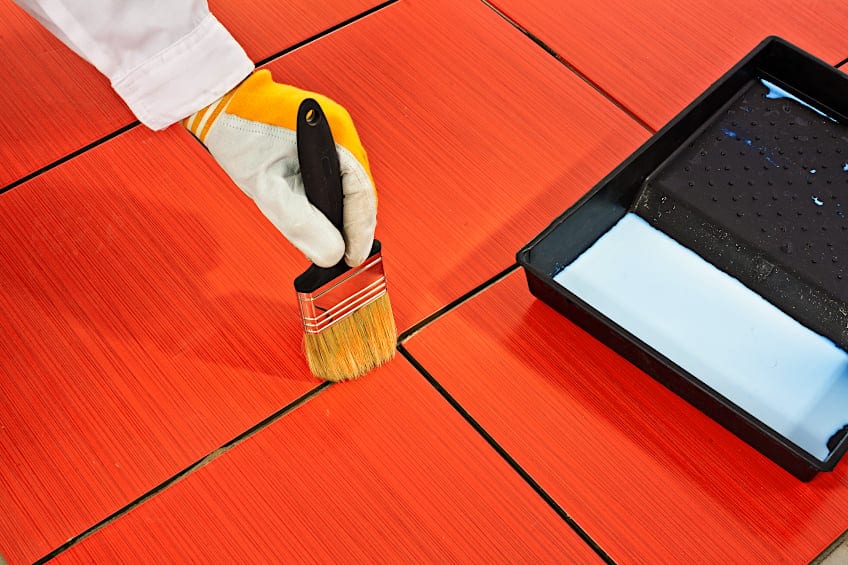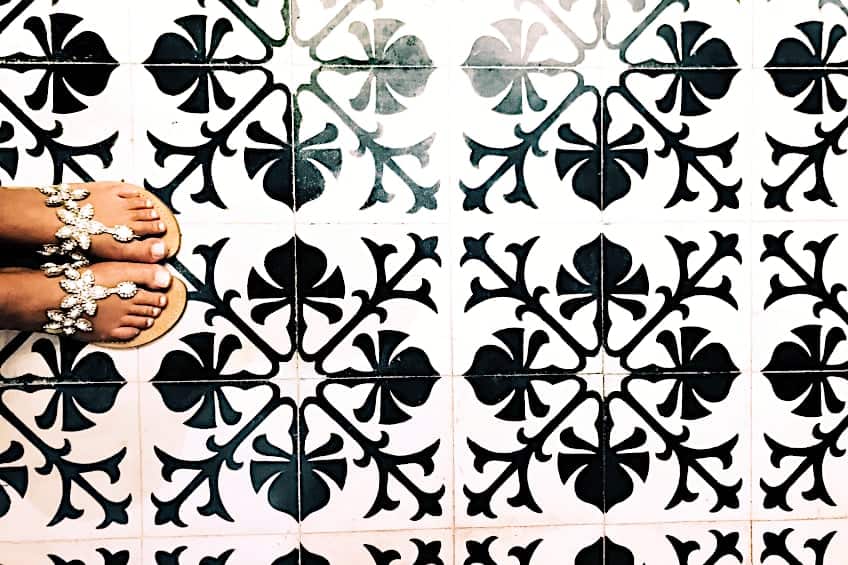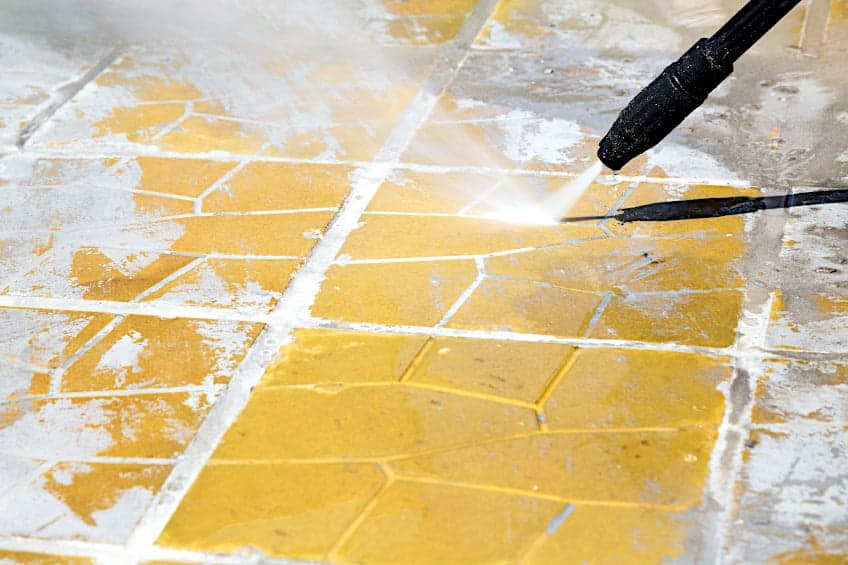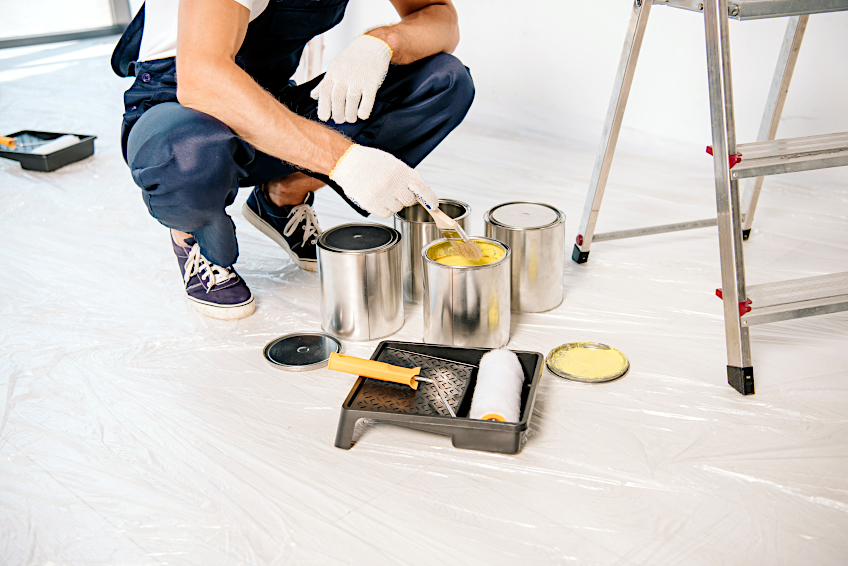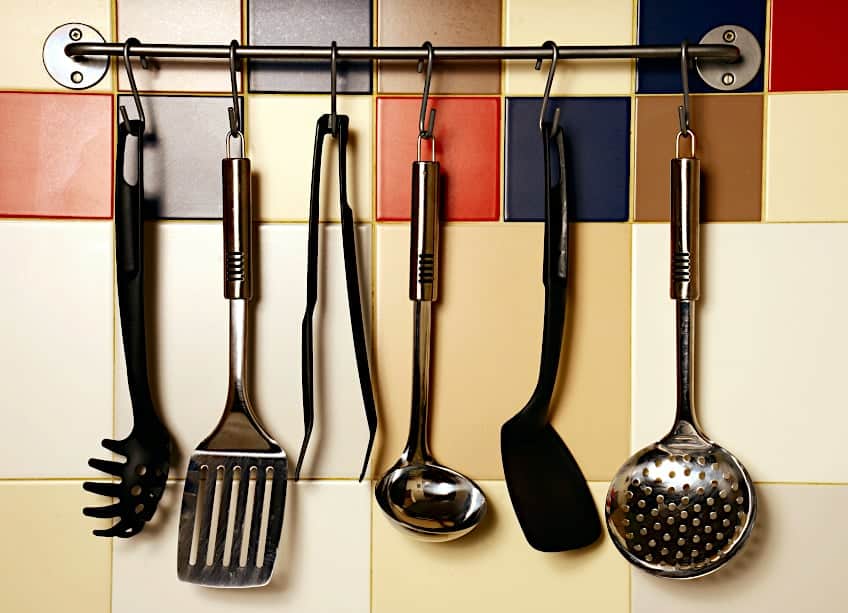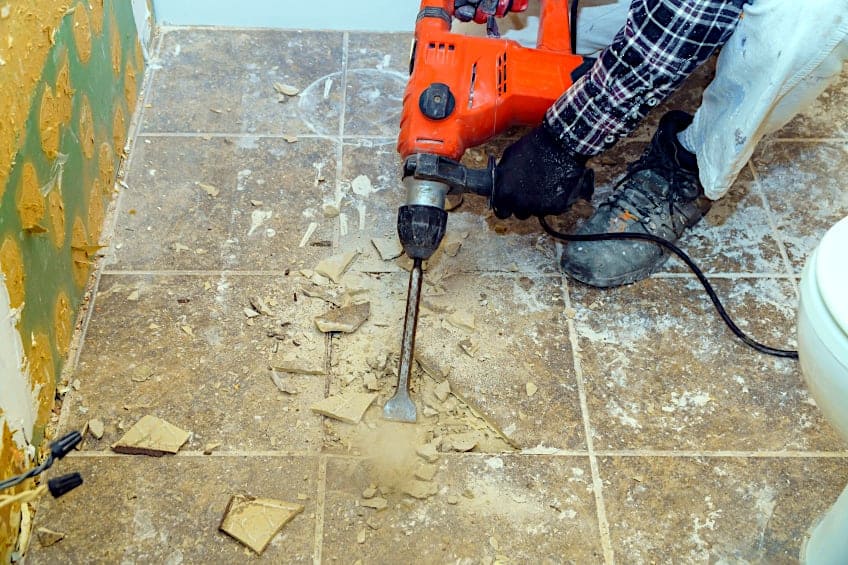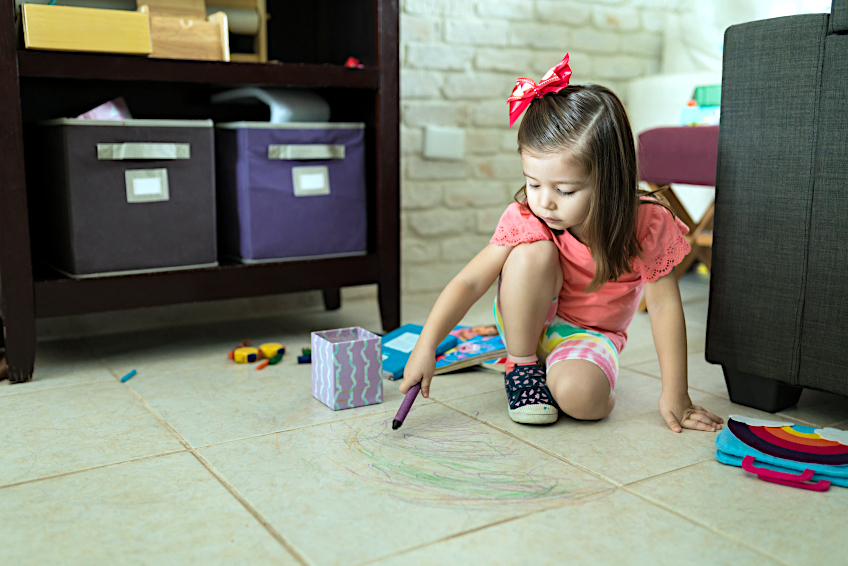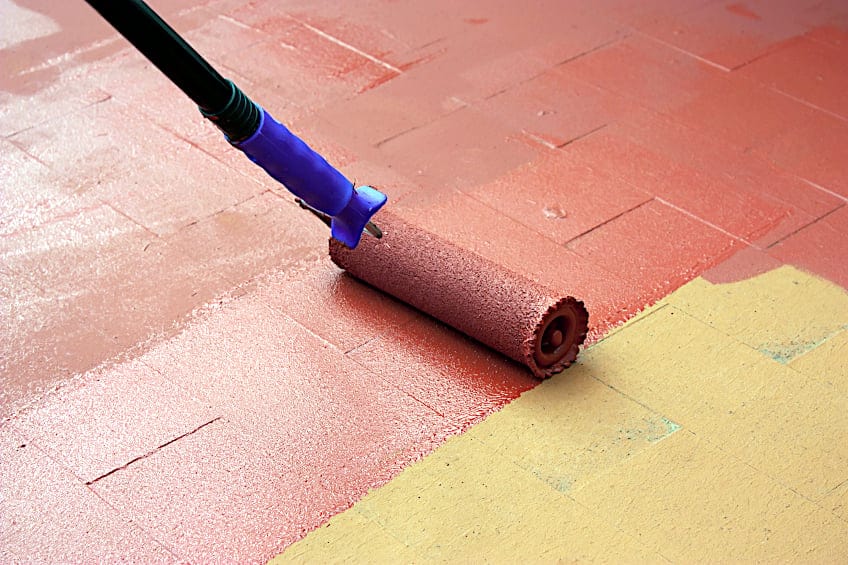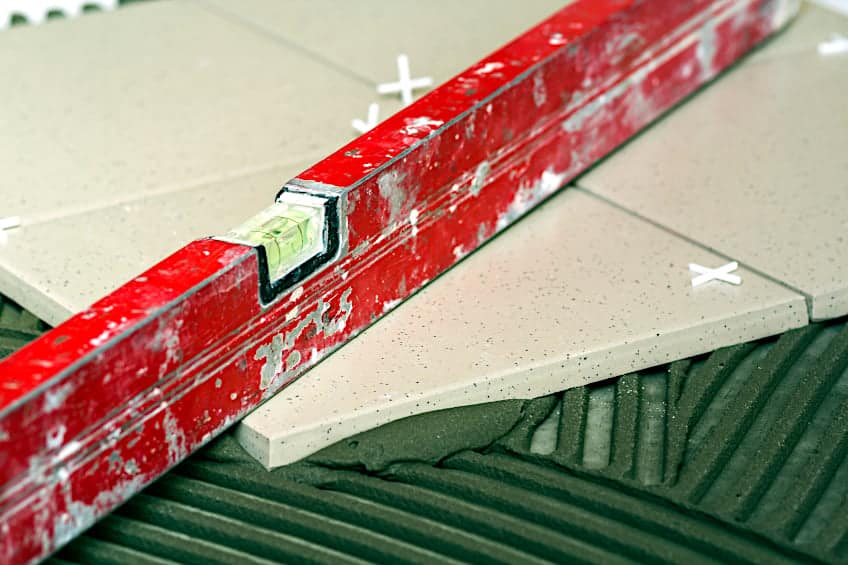How to Paint Ceramic Tile Floor – Tips to Ensure a Durable Coating
This post may contain affiliate links. We may earn a small commission from purchases made through them, at no additional cost to you. You help to support resin-expert.com
When it comes to flooring, making a choice between materials can be challenging. There are loads of options to choose from, all of which have their own advantages and disadvantages. Hardwood flooring creates a warm and inviting feel, while stone flooring can give your home or office an air of class and timelessness. Tiled or ceramic flooring on the other hand, is a good compromise between class and warmth, and depending on what pattern you choose to go with, you could achieve a similar feel in your space as you’d get from hardwood and stone. This being said, is it possible to paint ceramic tile? How would you go about it? What are the advantages and disadvantages of painting ceramic? Let’s have a look at how to paint a ceramic tile floor, what you should look out for, what paint you should use, and how to ensure that you get the best finish possible.
Table of Contents
Key Takeaways
Here are the summary for how to paint ceramic tile floors from our expert:
- It’s relatively easy to paint your ceramic tiles.
- It’s also way cheaper and takes less time to paint your ceramic tiles vs. replacing the tiles.
- The durability of your paint coat won’t last as long (up to 6 years) as it would if you have new ceramic tiles.
- We only recommend painting your ceramic tiles if you’re planning to replace the tiles within the next few years
How to Paint Ceramic Tile Floor Panels
Painting tiled floors is entirely possible. There are loads of reasons for painting tile floors too. After all, tile flooring takes quite a bit of wear and tear over time, from scuff marks to cracks, discoloration, and even chipping can occur if given enough time. If you’ve found yourself getting the itch to paint your tiled flooring, you can do a few things to ensure that the finish on your tiled flooring comes out looking as close to perfect as possible. Before we get into the how-to of the process, here are a few things you’ll need to get started.
- Floor cleaner
- Ceramic primer
- An orbital sander
- Scrubbing brushes
- Flooring paint and a topcoat or sealer
- Some painter’s tape
- Paint brushes
- A paint tray
- A paint roller (preferably a microfiber one)
- An extension pole for your paint roller
Clean Your Surface
Before we get into how to paint ceramic tile floor panels, let’s prepare your tiles. Painting bathroom tile floor surfaces can be tough, thanks to all of the grime that builds up on the surface. This build-up is caused because of the constant presence of moisture on the surface of the tiling, so, it’s best to clean it up before you begin the painting process.
How do you go about cleaning tiled flooring, you ask? Well, with some floor cleaner of course!
Get a broom and/or vacuum cleaner and give the surface of your floor a good once-over. Be sure to sweep in between the crevasses too and in those little nooks close to the edge of the wall too. Once you’ve got the loose dirt off the surface, it’s time to bust out your tile cleaner. Dilute your cleaner with some water and apply it to your floor. Next, take your scrubbing brush and give your floor an intensive clean.
Working in smaller sections ensures a more thorough clean, so do your best to be patient throughout the cleaning process.
Prepare Your Surface
Now that your surface has had a good clean, it’s time to prepare it for painting. Painting bathroom tile floor can be messy (or anywhere else you’re painting tile for that matter). This is why you will be using some painter’s tape to ensure that your paint only goes where you want it to go using some painter’s tape. Apply as much as necessary along the edges of the walls and counters surrounding the tiled floor and ensure that they are pressed down firmly.
The best way to go about this is to apply it as tightly as possible and use something along the lines of a paint scraper or an old rewards card to flatten it as you go along. Once you’ve applied all the tape, you’ll need to try running your hand along the surface of the tape to feel around for any bubbles that might be present.
Sand and Prime Your Surface
The big challenge is not really how to paint ceramic tile floor panels, but rather how to ensure your paint adheres well. It’s always a good idea to sand down any surface before you paint it. Sanding increases the surface friction of the tiles which in turn ensures that your primer and paint adhere well. We recommend using an orbital sander to scuff up the surface of your tiles, as using a belt sanding might reduce them to nothing, especially if you’ve never used one before.
Be sure to give them a light sanding. Sanding the tiles too hard can damage them, which kind of defeats the point of sanding them in the first place so be careful. Once you’re done sanding, be sure to clear all of the remaining dust by using a broom, vacuum cleaner, or compressed air before moving on to the next step in the process.
Before applying your primer, you should seal up any cracks or holes in the surface of your tiles. This includes any bits of grout that might have some pieces missing. All you need to do is fill them with a paintable caulk and you’re pretty much good to go. Finally, give your primer a good stir, pour some out into a paint tray, get a clean roller, and apply it to your tiles.
Be sure to work from the furthest point in the space to the existing one so you don’t paint yourself into a corner. Once your primer has been applied, allow it to dry for the manufacturer’s recommended time period before moving on to the next step in the process. Also, do your best to ensure that no dust or sand can enter the room easily while the primer dries.
Prepare Your Paint
It’s time to get your floor tile paint ready. Remember that your floor tile paint has probably been sitting on a shelf for a while, and as a result, all of the heavier particles have probably sunk to the bottom of the can. Using ceramic tile paint like this will result in a poor finish and paint that won’t adhere correctly. So, how do you remedy this?
All that you need to do is give your ceramic tile paint a good stir before you use it. It’s super easy, get a stick, tube, or professional paint stirring attachment for your drill and mix the paint until all of the heavier particles are infused into the paint solution. Once you’re happy with the job you’ve done painting, get a brush and test some of the paint on an inconspicuous area of the tile, before using on the entire floor.
Paint Your Flooring
Finally, here’s how to paint ceramic tile floor panels. Painting your flooring is pretty easy. Once you’ve tested your paint, it’s time for you to get busy. Start by painting the hard-to-reach areas of your flooring by using the edge of the paintbrush. This technique is ideal for the edges and corners of the space you’re painting, so do your best to cut the edges of the tiling where the painter’s tape meets the floor.
Once you’re done painting the smaller details of your floor, it’s time to get into the meat of the work. Get out your paint roller and painter’s tray. Pour some of your ceramic tile paint into the tray and get some paint on your roller. It’s time to get painting! You want to start painting at the point that is furthest from the door and work your way towards the exit.
When painting with your roller, consistency is the key to achieving a good finish. Both the quality of paint on your roller and the amount of pressure you apply to it need to be just right so that you don’t end up with any blotchy areas. Once your paint has been applied, you should allow it to dry for the manufacturer’s recommended time period before attempting to apply another coat of sealant.
Seal Your Flooring
Sealing your floor ensures that your paint will not be damaged, so, even though it’s not explicitly required, we highly recommend using a sealer. Before applying your sealer, you should remove any dust and dirt present on the surface of your painted floor, just be sure that it’s completely dry first. Once you’re sure your floor is clear of dust, it’s time to get your sealer ready.
Prepare your sealer or “topcoat” as stated by the manufacturer. Once you have the sealer prepared, it’s time to get to sealing. Pour some sealer out into your paint tray and use a fresh roller to apply the sealer to the surface of your floor. Be sure to use a thinner roller when applying your sealer, as the paint can scratch quite easily especially since it’s been applied so recently.
Once your first coat of sealer has been applied, ensure that you allow it to dry for the manufacturer’s recommended time period before applying any additional coats. This usually takes around 24 hours so you can take a well-deserved break before applying your final coat, (if you’d like to do so). Once you’re satisfied with your sealer, allow the paint and sealer to breathe for a few days before putting any weighted objects on the surface.
Will a Painted Floor Last?
This is a bit of a tricky question to answer. Painting a floor is not what many would consider a long-term solution because of the inherent nature of paint. It tends to scratch and peel over time, and even if you have applied a polyurethane coat or sealer, this will inevitably degrade and rise away from the surface over time.
This is very much unlike stone or wooden flooring which, even though it can degrade over time, doesn’t require nearly as much maintenance and repair as any painted ceramic surface does. You will need to patch up and resurface your painted tile flooring every once in a while, due to scuffing and the overall effects of foot traffic even if it is sealed.
However, using a high-quality polyurethane coating or sealer for your ceramic surface is a good way to reduce maintenance and ensure that cleaning the surface is that much easier. Essentially, what you’ll be doing is creating a nice layer of protective coating over your painted tile, a lot like the clear coat you’ll find on most new automobiles to ensure that paint doesn’t get scratched.
How Long Do Painted Tile Floors Last?
This is a good question. The durability of any resurfacing job is important, and when it comes to painting over your tiles, it pretty much comes down to the quality of paint and sealer you choose to use. Acrylic paint tends to be more durable than its latex counterparts, or you could choose to use a paint that has been specially formulated for flooring.
You should always consider the quality of the sealer that you use to finish your paint job too. This is the contact surface that you’ll be walking on, and it will be absorbing any damage you throw at it. A high-quality polyurethane ceramic sealer will do a great job in sealing your floor, so shop around in-store online, and check out as many reviews as possible before committing to one. Painted floors can last for around six years if a high-quality product is used, and if you take relatively good care of them.
Are Painted Floors a Long-Term Solution?
Wondering if paint can be used as a long-term solution for your tiled floors? This really depends on your definition of “long-term”. If you’ve gone with high-quality paint and sealer, your floor can last for up to six years with minimal maintenance needed. However, if you expect the same durability that you’d get from a stone or hardwood floor you’re going to be disappointed.
If you are prepared to put some effort into maintaining your flooring fairly regularly, it can last for a fairly long time before it needs to be completely resurfaced. When it does come time to resurface your floor, all it takes is some sanding, power-washing, and some new paint and sealer and you’re good to go. If you don’t have the time (or simply don’t want) to do regular maintenance you should consider a stone floor instead.
How Expensive Is Painting a Tile Floor?
Painting a tile floor is not expensive at all, especially compared to the alternatives. Wooden floors can cost loads of money to source and cut, and stone flooring can cost even more to install, seal, and maintain. All you need to paint your tiled floor is some paint, a roll of painter’s tape, some sealer, and primer. These can all be purchased on a fairly small budget and takes little effort to execute.
However, if you fail to properly seal your floor it can quickly become more expensive than this. Paint is not designed to handle the constant friction that foot traffic puts on it, so failing to seal your floor could result in you having to repaint it pretty soon. This being said, you should consider using a good sealer, if you don’t use very good paint.
What Type of Paint Works on Tiles and Ceramics?
Wondering what type of paint to use on tiles and/or ceramics? Well, most companies simply market the paints as tile or ceramic coating paints. While this means that you won’t have to look very hard to find paint that works on tiled surfaces, it doesn’t really explain what type of paint gets the job done. So, what kind of paint does work on ceramics and tile then?
The paint that tends to work the best on tiles and ceramic tends to be latex-based paints and acrylic-based paints most of the time. The latter works better as it is not water-soluble and bonds to the tile quite nicely. Acrylic paint also tends to be far more resilient to impact, abrasion, water, and direct heat, and even absorbs sound a bit better.
Even enamel paints work, and they’re pretty good too because they create a nice thick layer between the tile and surrounding environment. Just be sure to use a high-quality primer when applying any tile paint to ensure maximum adhesion.
Common Questions About Kitchen Tile Painting
Paint is used to improve loads of surfaces every single day, but tiles are usually installed as is and eventually replaced over time. Therefore, it makes sense that there is some confusion regarding the painting of tiles. This is why we’ve prepared a short section detailing some of the commonly asked questions about painting tiles and/or ceramic surfaces in general.
Is It a Good Idea to Paint Your Kitchen Tiles?
There’s not really a straight answer to this question considering that there are both pros and cons to painting your kitchen tiles. Painting your tiles is a cost-effective way to breathe life back into old tiles without having to go through the process of replacing your tiles completely. You could also paint your tiles as a temporary measure.
This allows you to experiment with color before replacing your tiles at a later date.
So, what are the pros and cons associated with painting your tiled floors? Well, some of the pros of painting a tiled floor is that (as we mentioned previously) it is inexpensive compared to many alternatives. It’s also far faster than ripping up your floor and replacing it with new tiles, which can take days if not weeks depending on the size of the space.
Painting your tiled flooring also takes considerably less effort compared to installing new flooring. This being said, painting your floor is the ideal solution to re-flooring if you don’t have any extra hands around to help you out. All you need is your paint of choice, a roller, and some painter’s tape to make your tiled flooring look as good as new all on your own!
However, there are a few drawbacks to mention regarding tiled flooring. Because you’ll likely be adding pretty vibrant color to the surface of your flooring, things like dust and grime will be a bit more noticeable compared to ordinary tiling. Furthermore, it can also be a bit of a challenge to maintain a painted tile floor because it does fade and scuff over time, which means you’ll have to touch it up every once in a while.
You should keep in mind that painting a floor in small spaces can make living in that space quite difficult while the paint dries. Even though some paints like latex don’t contain many VOCs (volatile organic, compounds), the smell of the paint in small areas can be a bit tough to manage unless it is well ventilated, which is another problem you can avoid entirely simply by retiling.
Another noticeable disadvantage of painting a floor instead of retiling is that if you don’t have enough experience, or skip a step, it can ruin your ceramic tiling for good. Simple mistakes like using the incorrect paint, not allowing the paint or sealer to dry completely before subjecting it to foot traffic, or cleaning with corrosive chemicals can ruin your floor, forcing you to retile it.
- Cost-effective
- Works in time-sensitive scenarios
- Can be done with minimal equipment
- Can be done by one person
- A good temporary solution to retiling
- Makes scuffs and dirt more visible
- Requires regular maintenance
- Can make spaces unusable for a while
- Paints and sealers contain VOCs
- Easy to do incorrectly if you’re not experienced
Can You Cover Your Tiled Floors Cheaply?
Tiles are designed to have a lifespan and a degree of tolerance to certain forces. Over time they reach the end of their rope and often end up having to be replaced. If you’re not by the means to replace your tiles, then painting is an extremely affordable and relatively low-effort solution to unsightly tiles compared to other options.
If you were to take into account the things you need to paint a tiled floor compared to things needed to replace or resurface a tiled floor completely, it becomes immediately apparent that painting is the more budget-friendly option. Additionally, if you have no experience removing and installing tiles then doing so on your own could leave you wishing you didn’t.
On the other hand, even if you’ve never held a paint roller in your entire life, it’s reasonable to assume that you’d be able to paint a tiled floor with the right attitude and some practice. Besides, all you need to paint tiles is some primer, a sander, some paint, a roller, and some masking tape. Maintaining painted tiles is pretty low in cost too, which kind of makes up for the fact that it’s not a one-time expense.
Is Tiling Over Tiled Flooring a Good Idea?
While it might seem a bit strange to tile over existing tiles, it is entirely possible. If your tiles are in a good condition, applying another set of tiles over them is entirely possible, and you won’t have to settle for painting over them either. One of the drawbacks of doing this means that your flooring will be higher than it was, which might not be something you’re willing to put up with.
There are some things that you need to do before you install tile over the existing tile floor.
Ensure that the existing tile and grout have not absorbed any moisture over time. If it has, this moisture can seep into the new tile which can result in corrosion and cracks over time. You should always ensure that the old flooring is level before applying the new one.
If your floor isn’t completely level your new tiles won’t adhere to it correctly, which will pretty much leave you in the same position you were in the beginning. This being said, getting rid of any moisture and grime using a surface level to ensure your tiles are good to go before applying your new set will save you loads of time, effort, and money!
There are loads of ways to go about tiling over your existing tile once you’re sure it’s good to go. The conventional method is to pre-cut your tiles, apply mortar to the old tiles, and press your new tiles down firmly. Another popular method of going about it is to apply the mortar directly to each tile before you stick them down. This method saves loads of time and effort and is the ideal way to re-tile smaller spaces.
So, is tiling over existing tile a good idea? Yes, it can be. If you’re willing to correct any irregularities with your existing tiles and commit to retiling, then it’s a pretty good idea. Whether you decide to paint over your tile or tile over it, it really depends on your budget and the amount of effort you’re willing to put into the flooring.
Now that you know that it’s possible to paint your tile flooring, how to tile over existing tiles, what type of paint works best, how to go about it, whether it lasts very long, how much it costs, and what you’ll need to do it, it’s time for you to get out there and out your newfound knowledge to the test. Remember to ensure you use a high-quality sealer when sealing your painted tiles, and to check that your floor is level and moisture-free if you decide to tile over your tiles instead.
How to Paint Ceramic Tile Floor
Materials
- Floor cleaner
- Ceramic primer
- Orbital sander
- Scrubbing brushes
- Flooring paint and a topcoat or sealer
- Painter’s tape
- Paint brushes
- Paint tray
- Fiber paint roller
- Extension pole for your paint roller
Instructions
- Get a broom and/or vacuum cleaner and give the surface of your floor a good once-over. Be sure to sweep in between the crevasses too and in those little nooks close to the edge of the wall too.
- Prepare your surface. You will be using some painter’s tape to ensure that your paint only goes where you want it to go using some painter’s tape.
- We recommend using an orbital sander to scuff up the surface of your tiles, as using a belt sanding might reduce them to nothing, especially if you’ve never used one before.
- It’s time to get your floor tile paint ready.
- Painting your floor. Start by painting the hard-to-reach areas of your flooring by using the edge of the paintbrush. This technique is ideal for the edges and corners of the space you’re painting, so do your best to cut the edges of the tiling where the painter’s tape meets the floor.
- Seal your floor. Before applying your sealer, you should remove any dust and dirt present on the surface of your painted floor, just be sure that it’s completely dry first. Once you’re sure your floor is clear of dust, it’s time to get your sealer ready.
Frequently Asked Questions
Can You Paint Tile Floors?
Can you paint tile floors? Yes, you can. Painting over tiling is an easy and low-cost solution to upgrading the look of a space. All that you need is some paint and a roller to get started, and before you know it, you’ll be looking at a brand-new floor!
Can You Paint Ceramic Tiles?
Can you paint ceramic tiles? It is entirely possible to paint ceramic tiles. You should know that the best way to go about this is to use a high-quality primer on the surface of the tiles and ensure that they’re clean before applying it.
Why Shouldn’t You Paint Tiles?
There are those who say that painting a tile floor is a bad idea. Why? Well, tiled floors are usually used in highly traffic areas to reduce maintenance and make cleaning easier. This means that painted tiled areas often need a lot of maintenance compared to exposed tiles.


